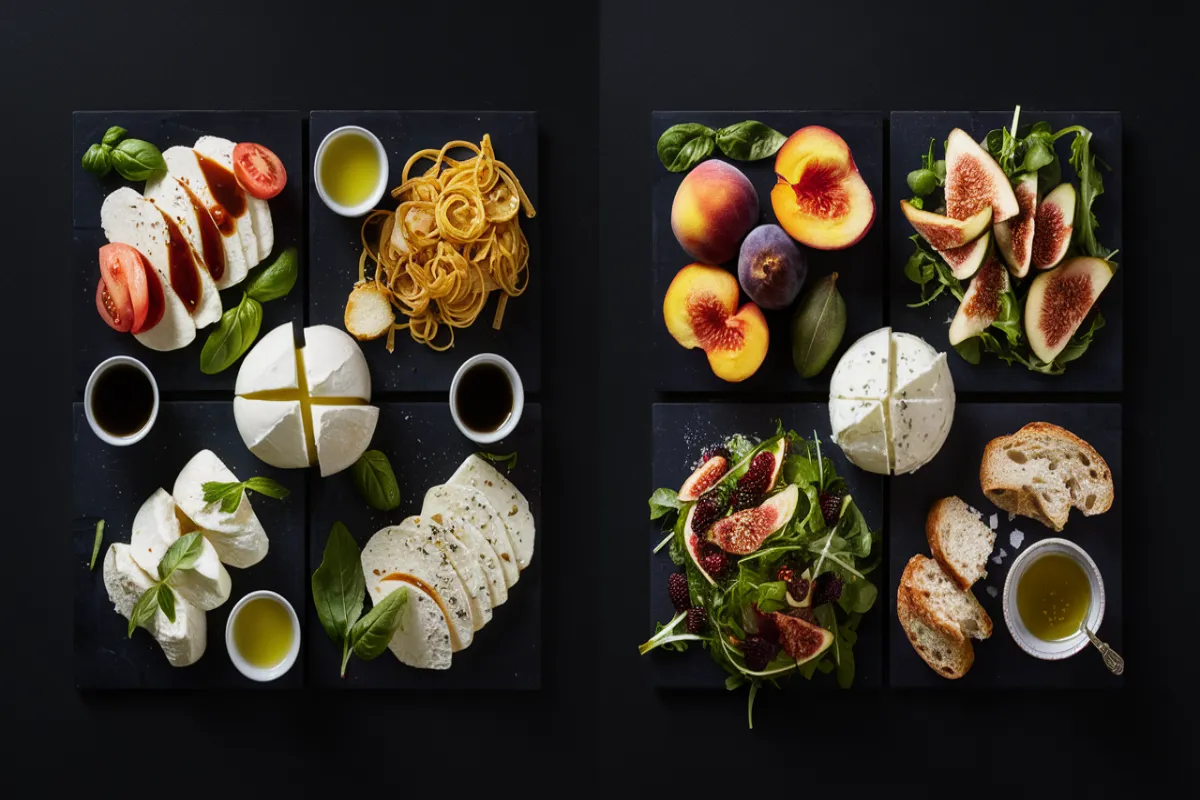They are two of the most beloved fresh cheeses in the world, both hailing from Italy and widely used in various dishes. While they share similar origins and are often paired with fresh ingredients, their textures, flavors, and uses set them apart. The question “what is the difference between mozzarella and burrata?” is common, as the two cheeses can appear similar at first glance, but their differences are distinct. In this detailed exploration, we will uncover the characteristics that define each cheese, their roles in cooking, and the unique qualities that make them stand out. Whether you’re a cheese lover or simply curious about expanding your palate, this guide will provide clarity on mozzarella versus burrata, allowing you to appreciate each cheese in its own right.
Introduction
When considering what is the difference between mozzarella and burrata, it’s important to recognize that while both cheeses are fresh and made from cow or buffalo milk, they diverge significantly in texture, taste, and preparation. Mozzarella is a semi-soft cheese that is known for its smooth, elastic texture and mild, milky flavor. Burrata, on the other hand, is mozzarella’s richer cousin, featuring an outer shell of mozzarella and a creamy, buttery center of stracciatella and cream. In this article, we’ll explore the contrasts between mozzarella and burrata, focusing on their preparation, uses, and unique characteristics, helping you understand the best ways to enjoy these two Italian delicacies.
Key Differences Between Mozzarella and Burrata
The key differences between mozzarella and burrata lie in their texture, flavor, and production process. These distinctions impact how they are used in cooking and how they pair with other ingredients. Let’s dive into the major differences between mozzarella and burrata.
1. Texture
One of the most noticeable differences between mozzarella and burrata is their texture.
- Mozzarella: This cheese is semi-soft with a smooth, elastic texture. It is slightly firm when fresh, making it easy to slice or tear apart. Mozzarella is known for its stringiness, especially when melted, which makes it ideal for pizza, lasagna, and other baked dishes.
- Burrata: Burrata, on the other hand, has a unique dual texture. The outer shell is made of mozzarella, which gives it a firm structure, but the inside is filled with a creamy mixture of stracciatella (shredded mozzarella) and cream. When cut, burrata oozes its rich, creamy center, making it a more decadent and luxurious cheese.
2. Flavor
While both cheeses are relatively mild, their flavor profiles differ due to their composition.
- Mozzarella: The flavor of mozzarella is mild, milky, and slightly tangy, depending on whether it’s made from cow’s or buffalo’s milk. Its neutral taste allows it to pair well with a wide variety of ingredients, from fresh tomatoes and basil to prosciutto and olives.
- Burrata: Burrata has a richer, more buttery flavor due to the cream filling. It is still mild but has a more indulgent taste compared to mozzarella. The creaminess of burrata makes it perfect for pairing with fresh fruits, vegetables, and light dressings, as the richness of the cheese can stand on its own.
3. Preparation Process
The preparation process of mozzarella and burrata is another major factor that differentiates the two cheeses.
- Mozzarella: Mozzarella is made by heating curds until they become elastic, then stretching and kneading the curds to create a smooth, cohesive ball. The cheese is then soaked in brine to maintain its moisture. This process gives mozzarella its distinctive texture and mild flavor.
- Burrata: Burrata begins similarly, with mozzarella being formed. However, the key difference is that once the mozzarella is shaped, it is stretched into a pouch. Inside this pouch, a mixture of stracciatella and cream is placed, and then the mozzarella is sealed to encase the creamy filling. This creates the soft, oozing center that defines burrata.
4. Usage in Cooking
Mozzarella and burrata are used differently in cooking, though they can sometimes be substituted for one another depending on the dish.
- Mozzarella: Mozzarella’s firm yet pliable texture makes it ideal for melting. It’s commonly used in hot dishes like pizza, lasagna, and sandwiches, where it provides that stretchy, gooey texture we all love. Mozzarella is also enjoyed fresh in salads like caprese, where its mild flavor complements fresh tomatoes and basil.
- Burrata: Burrata is best enjoyed fresh and is rarely used in cooked dishes due to its delicate texture. It is often served whole or halved, allowing its creamy center to spill out onto the plate. Burrata is typically paired with fresh vegetables, salads, bread, and light dressings. It’s a showstopper cheese, best enjoyed as a standalone element rather than melted into a dish.
Tips for Choosing Between Mozzarella and Burrata
Choosing between mozzarella and burrata depends largely on the type of dish you’re preparing and the texture and flavor you’re aiming for. Here are a few tips for deciding when to use mozzarella versus burrata:
1. Consider the Dish
If you’re making a dish that requires melted cheese—such as pizza, pasta, or a grilled sandwich—mozzarella is the best choice. Its firm texture and ability to melt beautifully make it ideal for hot dishes. If, however, you’re preparing a salad, antipasto, or an appetizer where the cheese will be served fresh, burrata’s creamy texture and rich flavor will elevate the dish.
2. Pairing Ingredients
Mozzarella’s mild flavor means it pairs well with almost anything, from cured meats to fresh vegetables. Burrata’s rich creaminess, on the other hand, works best with lighter, fresher ingredients that won’t overwhelm its delicate flavor, such as ripe tomatoes, peaches, or a simple drizzle of olive oil.
3. Texture Preference
When deciding between mozzarella and burrata, consider the texture you prefer. If you want a cheese that is smooth, firm, and stretchy, mozzarella is the way to go. If you’re looking for something with a luxurious creamy center, burrata will be your cheese of choice.
Pairing Suggestions for Mozzarella and Burrata

Both mozzarella and burrata are versatile cheeses that pair well with a wide variety of foods. Here are some pairing ideas for both cheeses:
1. Mozzarella Pairings
- Caprese Salad: Mozzarella, tomatoes, basil, olive oil, and balsamic vinegar.
- Pasta: Mozzarella can be melted into pasta dishes like lasagna, baked ziti, or pasta al forno.
- Pizza: Mozzarella is a key ingredient in many pizzas, offering that gooey, stretchy texture.
2. Burrata Pairings
- Fresh Fruits: Burrata pairs beautifully with fresh fruits like peaches, figs, or berries.
- Salads: Add burrata to arugula or mixed green salads for a rich, creamy element.
- Appetizers: Serve burrata with crusty bread, olive oil, and sea salt as a luxurious appetizer.
Tips and Tricks for Enjoying Mozzarella and Burrata
Whether you’re enjoying mozzarella or burrata, there are a few tricks to make the most of these cheeses:
1. Serve at Room Temperature
Both mozzarella and burrata taste best when served at room temperature. Remove the cheese from the refrigerator about 30 minutes before serving to allow the flavors to fully develop.
2. Pair with Simple Ingredients
When serving burrata or mozzarella, pair them with simple, high-quality ingredients. A drizzle of olive oil, a sprinkle of sea salt, or a few fresh herbs will enhance the cheese’s natural flavors without overpowering them.
3. Use Fresh Cheese
Mozzarella and burrata are best enjoyed fresh. Try to purchase these cheeses from a reputable source and consume them within a few days for optimal flavor and texture. The fresher the cheese, the better the eating experience.
Frequently Asked Questions (FAQs)
1. Can I Substitute Burrata for Mozzarella in Recipes?
It depends on the recipe. If the dish requires melted cheese, such as pizza or casserole, mozzarella is the better option due to its melting properties. Burrata, with its creamy center, is best served fresh and does not melt in the same way. However, burrata can be substituted for mozzarella in fresh salads, appetizers, or as a topping for bruschetta or crostini.
2. How Should I Store Mozzarella and Burrata?
Mozzarella and burrata should both be stored in the refrigerator, submerged in their liquid (either brine or water) to maintain their moisture. Mozzarella can last for up to a week when stored properly, but burrata is best eaten within 24-48 hours of purchase for optimal freshness. Once opened, burrata should be consumed the same day.
3. Is Burrata Healthier Than Mozzarella?
Mozzarella and burrata are both fresh cheeses and are relatively similar in nutritional content. However, because burrata contains added cream, it is higher in fat and calories compared to mozzarella. While burrata offers a more indulgent experience, mozzarella is a slightly lighter option if you’re watching your calorie or fat intake.
4. Can You Use Burrata on Pizza?
Burrata can be used on pizza, but it should be added after the pizza has finished baking. Because burrata’s center is creamy and doesn’t melt like mozzarella, adding it to the pizza during baking would result in an unappetizing texture. To enjoy burrata on pizza, top the pizza with fresh burrata just before serving for a rich, creamy addition.
5. What Are Some Common Pairings for Mozzarella and Burrata?
Mozzarella pairs well with a variety of ingredients, such as tomatoes, basil, olive oil, balsamic vinegar, and cured meats. Burrata is often served with fresh produce like tomatoes, peaches, arugula, or figs, as well as simple dressings of olive oil and sea salt. Both cheeses are excellent with crusty bread, and burrata’s richness makes it particularly well-suited to being the star of a dish.
Conclusion
Mozzarella and burrata are two incredible cheeses that each bring something unique to the table. Understanding what is the difference between mozzarella and burrata can help you choose the best cheese for your dishes and expand your culinary horizons. Mozzarella’s firm, stretchy texture makes it perfect for melting in cooked dishes, while burrata’s creamy interior is a show-stopping addition to fresh salads and appetizers. By knowing when and how to use each cheese, you’ll be able to fully appreciate their flavors and textures, making your meals even more delicious.

